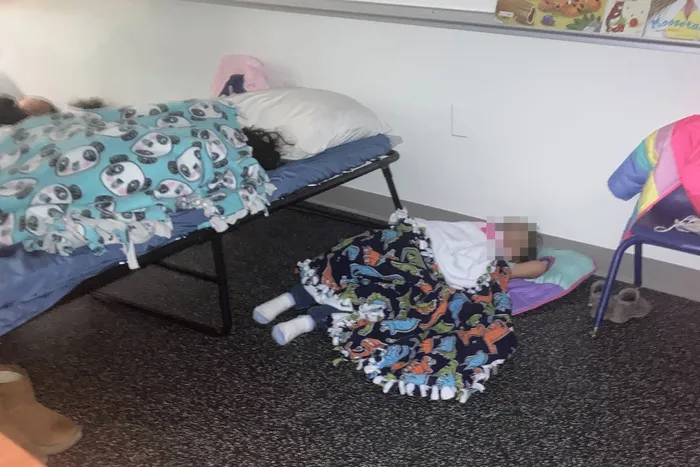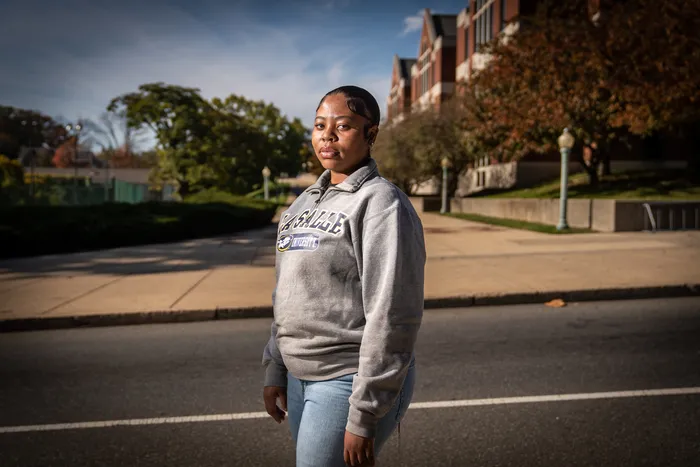Pennsylvania lawmakers are trying to limit damage awards to kids injured in the child welfare system
PCCYFS President/CEO Terry Clark quoted

Child welfare advocates say the cap won’t address the underlying issue: longstanding staffing shortages.
Monday, April 6, 2022 – Steve Volk (Billy Penn/Broke in Philly)
At a Pa. House legislative committee hearing this January, attorney Nadeem Bezar introduced lawmakers to some kids he has represented in court.
He started with a boy shaken so badly in his infancy that he suffered a traumatic brain injury. Then he talked about a second boy, submerged in boiling hot water till the skin sloughed off his body. Then a girl who was held down and burned with an iron, her skin contracting so severely that she still has difficulty walking.
Bezar mentioned each of these kids and more in his opening remarks, arguing against newly proposed legislation that would cap the damage awards that nonprofit child welfare agencies could be liable for in physical abuse cases at $500,000, a number he stated would be insufficient to cover the lifetime’s worth of medical and mental health bills these kids will face.
Proponents of the new legislation, including insurance professionals and nonprofit child service agencies, argue a cap is necessary to reduce skyrocketing insurance rates, which threaten the ability of providers to stay in business.
“These bills are designed to ensure that child welfare providers can keep operating,” said Kate Klunk (R-York), who sponsored the legislation, “and to protect children who need the services these agencies provide.”
That the people in a field responsible for helping children would seek to deny financial awards to injured kids suggests a loss of focus, say child advocates, including Bezar and fellow civil attorney Nancy Winkler.
Klunk’s legislation might also unwittingly mask a more fundamental issue: a workforce shortage that underlies many abuse lawsuits.
Costs skyrocket as providers scramble for staff
Klunk’s bills (HB 2213 and 2214) include a straightforward cap on damages against nonprofits in nonsexual abuse cases.
In the last five years, city civil attorneys have brought in numerous large damage awards or settlements in cases involving injuries to children, including $5 million for a girl abused by her foster father, a $4.5 million verdict in a 2018 case involving two Philadelphia twins who were beaten in the foster home of a family in Lancaster, and an $11 million 2017 verdict against a child services agency and the adoptive parents of a girl who was physically and sexually abused.
During this same time, insurance rates, particularly for nonprofits, have risen.
A Feb. 2020 article in Insurance Journal, a trade publication for industry professionals, bemoans the increases, stating that “large jury awards for sexual abuse cases” have “spooked” [insurance] carriers, particularly for nonprofits serving children, who face greater risk of “molestation” and “abuse.”
A spokesperson for one local child welfare provider stated that their own premiums have risen from just over $100,000 about five years ago to more than $1 million per year today. They asked not to be identified, for fear of becoming a target for critics.
Philadelphia’s Department of Human Services stated in an email response to questions for this story that it is “standard for DHS to pay insurance costs for CUAs” — the so-called Community Umbrella Agencies divided across 10 regions of the city, which Philly started outsourcing its foster care services to about eight years ago.
The CUAs, which are nonprofits, say these payments come out of their operating budgets and don’t cover payouts.
“Our members have been clear that these rates are a threat to their ability to operate and function,” said Terry Clark, President and CEO of the Pennsylvania Council of Children, Youth and Family Services (PCCYFS), a statewide organization representing about 100 mostly nonprofit service providers with more than 10,000 employees.
Clark also spoke at the same January legislative where Bezar appeared.
“Providing 24-hour care through foster care, adoption or residential services, carries inherent risk,” Clark stated. “Agencies that support traumatized children and families face increasing costs but stagnant funding and a shrinking workforce.”
The workforce shortage is related to the damage awards and increasing insurance premiums, Clark said in a follow-up interview.
“You have providers who are struggling now to employ people that are your qualified, skilled laborers, who really want to be there for the purpose of helping kids. And they’re also now struggling with trying to make sure that they aren’t providing a service or program that’s putting children at more risk from having a lack of staff or not the right type of staff or the not the right skill level of staff. So it all does connect.”
Caps don’t necessarily reduce insurance rates, experts say
PCCYFS released a report last November describing a “workforce crisis.” Members of the child welfare provider council reported an average worker turnover rate of around 30%, about three times higher than the recommended industry standard.
The problem appears particularly urgent in Philadelphia.
Philadelphia DHS, which is legally responsible for providing foster care services, regularly releases a “report card” rating each CUA’s performance. In the most recent report, published in January, six of the city’s 10 CUAs were ranked “unsatisfactory” or “critical” in workforce retention.
The city’s metrics for rating CUAs, provided in an emailed response to questions, indicates that even CUAs with a 70% staff retention rate qualify for a three-star rating of “competent.” Two additional CUAs fall into that category, potentially compromising services.
In light of this, say some child advocates, capping the awards due to children and youth injured in the system is like shooting the messenger, hurting the very people who are alerting the city to a deeper crisis.
And caps in general haven’t proven successful.
In 2017, a Wisconsin appeals court sided with the plaintiffs in a medical malpractice case that challenged a cap on jury awards. The court determined that any correlation between damage caps and medical insurance premiums or overall healthcare costs was “at best indirect, weak and remote.”
Other judicial jurisdictions had also failed to establish a connection, the court wrote, and many states without caps had higher physician retention rates than those with them.
Similarly, a comprehensive 2012 study conducted by a pair of Georgetown law professors found that caps generally hadn’t reduced premiums. And Steve Poizner, a former state insurance commissioner, has argued that the most reliable way to reduce insurance burdens is to establish an independent commissioner, elected by the voters, as Californians elected him. Pennsylvania’s insurance commissioner is politically appointed.
Short on staff, short on funding = not good for kids
“Staffing is at the heart of a lot of cases of abuse within the child welfare system,” said Nancy Winkler, who has filed successful suits on behalf of injured children and cites issues around training and high caseloads as key. “These lawsuits should incentivize the system to do better.”
In the 2019 beating death of a 4-year-old Philadelphia girl named Zya Singleton, caseworkers failed to monitor the girl’s well-being after she was relocated from her mother to a new guardian and foster mother.
Inexperienced or overburdened staff can simply miss things, no matter how much they care, and turnover in child welfare services is a persistent problem, rendered worse by the Covid-19 pandemic, which shook up employment trends across various sectors.
Difficulty maintaining adequate staffing levels is a perpetual issue in Philly and elsewhere, long preceding any concerns over increased damage awards. The starting pay for an entry level case manager in Philadelphia is around $44,000 for a job with massive emotional and physical demands, long hours that bleed into personal time, and the pressure of making crucial decisions about kids and families.
Nonprofit human services organizations around the country are also contending with a dynamic noted by child service providers in Philly and around the state, according to research by the Alliance for Strong Families and Communities (now Social Current) and the American Public Human Services Association:
Many government contracts fail to cover the full cost of providing services.
One local manager, who requested anonymity because they didn’t have permission from their employer to speak to the media, said that when issues of low salaries, worker turnover and high caseloads are raised, DHS managers have told them “to fundraise.”
A spokesperson for DHS said there are “many opportunities during the length of a contract for CUAs to seek changes.”
Jody Levison-Johnson, president and CEO of Social Current, which represents more than 1800 social sector nonprofit organizations nationwide, suggested a potential solution: “Providers and government agencies both need to take responsibility to engage in honest cost finding and cost studying, and government agencies must be prepared to pay true costs, to provide full services, because you get what you pay for.”
Levison-Johnson isn’t aware of any model community with these kinds of relationships in place, however. She noted that the new mayor in New York has formed a task force to look at the challenges facing nonprofits. A special committee in California’s state Senate is also holding hearings on the state of the nonprofit workforce there.
In Philly, children’s service providers are also forming a committee, to be co-chaired by Frank Cervone, executive director of the Support Center for Child Advocates, to look for potential solutions.
“Turnover like this compromises services for children and families,” Cervone said, “because new workers don’t have that memory of what kids and parents have been through or accomplished.”
Big awards can draw attention to trouble spots
The shift in Philadelphia to outside contractors has exposed CUA nonprofits to lawsuits and damages the city hasn’t traditionally seen.
The bar to sue government agencies in the act of providing services is high, and in Pennsylvania damage awards against government agencies are already capped for cases not involving sexual abuse at $500K by state law. The CUAs, run by private companies, don’t enjoy the same immunities, and so civil attorneys like Bezar and his clients have utilized this new avenue to seek compensation.
Compounding the problem, contract language in Philadelphia and other counties around the state indemnifies the government from civil liability arising from cases that have been assigned to outside providers.
“It’s an unfair arrangement,” said Clark, speaking on behalf of his members, which includes most of the city’s CUAs. “Government is saying, ‘We’re not going to compensate you for the cost of care, and you’re also going to be the one who pays when something goes wrong.’”
Klunk’s second bill would make contract language indemnifying the city from such suits unenforceable. But for Bezar, this entire conversation needs to center on the kids.
“If a staff member has too many kids on their case lists,” said Bezar, “bad things are going to happen. And there are two ways to fix this. Either increase the amount of staff, so that each caseworker has fewer kids. Or reduce the number of kids in the system.”
Either way, he said, “Kids are not being harmed because of large litigation verdicts. These verdicts actually might be the reason they get saved, because attention is being drawn to this.”
Susan Vivian Mangold, CEO of Juvenile Law Center, which advocates for young people, knows which of Bezar’s options she’d choose. “We’ve got a system that isn’t supporting families so much as investigating them and separating them,” she states, “which is hugely expensive, whereas supports cost less.”
Across the country, child welfare experts have issued recommendations to reduce the number of kids in foster care by 50-percent or more because most kids in the system are not actually there for reasons of abuse. Mangold sees the spate of civil suits and the workforce issues as reasons to embrace “right sizing” as a potential solution, allowing social service workers to pay more attention to the cases that require it.
“These lawsuits should serve as a wake-up call that kids are being severely harmed in care,” concludes Mangold. “We need a different way of doing things.”



